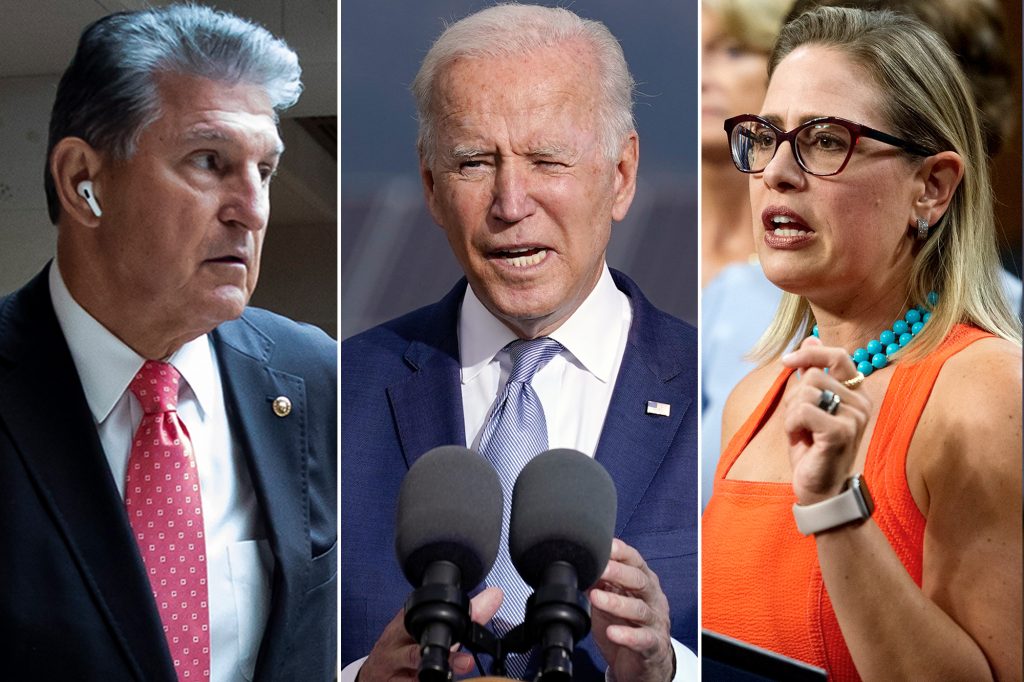Joe Biden was swept into power with a commanding mandate. He handily won the election — both in the popular vote and in the Electoral College — and his party was able to eke out control of both houses of Congress. To add to matters, just weeks before he took office, Biden’s primary political opponent — Donald Trump, the boogeyman of the Democratic Party — was badly damaged when his supporters stormed the Capitol. This escalation created a partial break between Trump and the rest of the establishment. No longer acceptable, he had to be cast out and his followers disciplined. After a wave of arrests, bans, and speeches about the importance of democracy, Biden took power with his primary political enemy at an all-time low. Here was Joe Biden to save us from the nightmare of the Trump administration. Here was a man who could restore the institutions of the state from the damage Trump did.
The first few months of the Biden administration were relatively smooth sailing. Biden was able to pass a massive stimulus — kicking off “Bidenomics” — and several other pieces of his agenda without much trouble. In recent weeks, however, the honeymoon has drawn to a sharp close. Biden’s approval ratings have fallen, there are major stumbling blocks delaying his agenda, and Trumpism is far from defeated. Nowhere can Biden’s challenges be seen more clearly than in his own party.
The Civil War
From 2015 to 2020, the Democratic Party was rocked by a civil war. Fed up with the establishment and newly politicized, a new Left emerged within the party, championed most notably by Bernie Sanders. Sanders and his base challenged the party establishment to the point that, in order to protect their hand-picked candidate, the party leadership had to maneuver against Sanders not once but twice, in 2016 and 2020. The civil war wasn’t just limited to the fight for the presidential nomination but could be seen on just about every level. Suddenly, members of the progressive wing were primarying sitting Democratic leaders and winning. There was a fierce fight to lead the Democratic National Committee after the former chair had to resign for collaborating with Hillary Clinton to shut down the Sanders campaign. The DSA became a major phenomena and was able to intervene in elections to get their endorsed candidates elected. In Congress, the newly elected “Squad” challenged the authority of Nancy Pelosi and the establishment.
Of course, both of these wings were united by key agreements — protecting capitalism and the state— and they largely voted together, even when those votes opposed the progressive rhetoric of the party Left.
Biden’s campaign to be the Democratic presidential nominee epitomized this crisis. Biden was unpopular, losing badly in the first few contests. Sanders seemed, for a time, as if he might finally defeat the establishment and take power for the party Left. So, once again, the establishment did what it does best: it worked together to defeat the Left. Congresspeople came out in support of Biden — most notably Elijah Cummings, whose endorsement many believe gave Biden the win in South Carolina — and party leaders such as Barack Obama began to make phone calls. One by one, candidates dropped out of the race, clearing the way for Biden. Whatever issues they had with Biden, the Democratic establishment was united in opposing Sanders.
So Sanders was defeated once again, and once again he chose not to fight but, rather, give fealty to the people who conspired to defeat him. In a scorching betrayal of his left-wing base, Sanders endorsed and campaigned for Clinton and Biden. So did the Squad and the rest of the Democratic Party’s Left. “Biden may not be our guy,” the reasoning went, “but he’s better than Trump, and we’ll be able to pressure him to give into our demands.” Out of fear and opposition to Trump, the progressive Democrats, the NGOs, the unions, and much of the Left put down their weapons, ended the Democratic Party civil war, and stood behind Biden.
This coalition of everyone from Henry Kissinger to AOC propelled Biden to victory. And, for a time, it looked as if the civil war had finally abated. AOC and the Squad stood behind Pelosi, Sanders was installed as chair of the Congressional Budget Committee, and Biden seemed to be making some concessions to the Left. But it didn’t take long for pressure to come at Biden from the party Right.
The Right Wing Strikes Back
For the bulk of the Democratic civil war, the right wing and the center were united. Both opposed attempts by Sanders and others to move the party left, and both protected the establishment and the institutions of the state against criticism from the Left. There were cracks, however. The Democratic Party Right, led by Joe Manchin, took a more conciliatory position toward Trump, working with him and supporting his nominees far more often than either the Democratic Party Left or Center. For example, Manchin voted to confirm Brett Kavanaugh, the only Senate Democrat to do so.
In 2019, Manchin gained a valuable ally when Kyrsten Sinema became a Democratic senator for Arizona. While Manchin, an old straight white man from West Virginia, was a perfect avatar for the Democratic Party Right, Sinema presents more contradictions. She’s young, openly bisexual, and — nominally — stylish. Sinema’s specific brand of identity politics and right-wing economic policy has made her into an incredibly influential figure in the Democratic Party.
The power of the Democratic Right has been massively increased thanks to the Democrats’ hold on the narrowest-possible margin of control in the Senate. This means that, effectively, Manchin and Sinema can veto Biden’s agenda. And, by and large, they have.
Sinema voted down a minimum wage, Manchin is protecting the Hyde Amendment, and both of them are working together to sink the infrastructure bill. While the party Left, by and large, has towed the line and followed Biden’s lead, the Right has posed more of a problem. This has led Biden to shift away from concessions to the progressives — the so-called Bidenomics — toward more concessions to the Right.
The rebellion of the party Right isn’t necessarily a bad thing for Biden, however. By fighting Manchin and Sinema’s more right-wing agenda, Biden and the rest of the party establishment can paint themselves as more progressive than they are. They can also use Sinema and Manchin as an excuse for watered-down policy while retaining their more reformist rhetoric. In other words, Biden faced a contradiction between his allegiance to capital and the demand of his base to be more progressive. Using the right wing as an excuse could be one way for Biden to resolve this contradiction without opposing sectors of capital.
The Center Cannot Hold
This has led to a breakdown of relationships between Biden and the party Left while doing little to address the crisis to the Right. Progressives have begun to swing their weight around with the same tactic that has served Manchin and Sinema so well: threatening to withhold votes unless their policy demands are met. House progressives have used this to pressure a vote on the infrastructure bill and the reconciliation bill. While certainly nothing resembling a true progressive opposition to the government, these moves are a significant escalation in the progressives’ tactics to influence the party line. This shouldn’t be overstated; progressives aren’t fighting for control of the party, and, by and large, they are portraying themselves as the true defenders of the Democratic Party line, a far cry from the anti-establishment rhetoric of just a few months ago. But it is important that the progressives are beginning to flex their muscles more than they have for the rest of the Biden administration.
On the other hand, Biden’s attempts to appease the party Right is not having the desired effect. Relations between Manchin, Sinema, and the White House have broken down even more than they did before. Sinema, apparently, is not taking Biden’s phone calls, but she is talking with Mitch McConnell. Manchin and Sanders are in a deep struggle over the contents of the infrastructure bill, and Biden is being called on to act as mediator.
Given that Biden was chosen as the nominee specifically in an attempt to resolve the civil war and pacify the right wing, the worsening conflict within the party’s congressional wing is deeply damaging to Biden. In addition, his economic recovery plan is not going as hoped as the economy shows signs that a recovery is still very much a pipe dream. Add to that Biden’s falling poll numbers and the president’s position seems much more precarious than it was just a few weeks ago.
We shouldn’t, of course, overstate Biden’s position. He is still the undisputed head of the party with a majority in both houses of Congress and all the institutions of the state at his disposal — institutions that he’s done a lot to attempt to rehabilitate post-Trump. Biden has also had to reorient American foreign policy to focus on China, which is in keeping with the consensus among bourgeois sectors. This gives him a lot of breathing room because, unlike Trump, Biden is in line with the mainstream perspective of the bourgeoise on foreign policy. So Biden isn’t in fatal danger, at least not yet. But the challenges to getting his agenda passed, as represented by the infrastructure bill that was supposed to be one his key pieces of legislature, seem likely to grow as the honeymoon fades and the midterms get closer. However you look at it, Biden is in more trouble politically than he’s been since taking office.
And it looks as if the crisis is only going to grow. Manchin and Sinema seem emboldened rather than disciplined. Sinema has become a major public figure — with glamorizing profiles by Maureen Dowd and others — giving her far more options to build her political profile if she chooses to. So, for her and Manchin, their strategy is working.
The progressives, for their part, are making demands on Biden, which puts them in explicit conflict with the party Right. With midterms just around the corner — and AOC allegedly planning a primary challenge to Democratic Senate leader Chuck Schumer — the progressives are likely going to have to fight the right-wing elements in the party more and more in an attempt to enliven their base. This is intensified by the fact that the progressives have, essentially, given up on all of their signature policy demands. To still keep their base inside the Democratic Party tent, they will have to portray themselves as more left than they are. This will, inevitably, lead to more conflict with the party Right and potentially the Biden administration as well.
If the 2022 midterms continue these trends, more members of the progressive wing will likely take seats in Congress, leading to more headaches for Biden in finding party consensus. Indeed, it seems as if the progressives are being ambitious about their ability to gain power in the midterms. AOC’s refusal to vote against funding for Israel’s Iron Dome was a clear attempt to win more votes, showing that she has begun to position herself as a more “mainstream” member of the party. It should be highlighted that, in order to get a better position in the party, the progressives are moving increasingly to the Right. So, even if they can gain more footholds in the party, the progressives will have become largely indistinguishable from the rest of the party, having traded their demands for power.
All of this is just a prelude to whatever is going to happen in the coming presidential nomination fight. Because, lest we forget, we live in a forever election; once the midterms are done, the presidential primaries will monopolize political discourse almost immediately. It is still unclear who the players will be in that contest , but it will force both the right and the left wings of the party to polarize more in an attempt to rile up their base.
All this creates problems for Biden in his attempt to unify the party and pass his agenda. If the problems continue to grow, the Democrats will likely be punished for their inaction in the midterms. This will lead to yet another round of recriminations and finger-pointing that surely will do nothing to fix the growing crisis within the party. The Biden era has been defined by a lower level of politicization and a retreat of the elements of organic crisis that were seen so prominently during the Trump years. And that trend is continuing, but more and more cracks are appearing. As the right and left wings of the Democratic Party continue to fight, it seems unlikely that Biden will be able to hold it all together. The center cannot hold, and darker days are looming for Biden.











